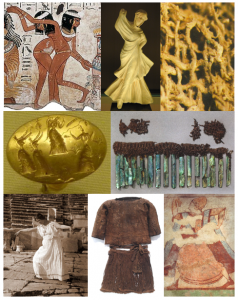 Appel à Contributions : « Textiles in Motion. Dress for Dance in the Ancient World », Ancient Textiles Series, Oxbow Books.
Appel à Contributions : « Textiles in Motion. Dress for Dance in the Ancient World », Ancient Textiles Series, Oxbow Books.
L’appel à contributions est accessible également sur le site internet du projet TEXDANCE : https://texdance.eu/15-10-2020-cfp-for-textiles-in-motion-dress-for-dance-in-the-ancient-world/
Textiles in Motion. Dress for Dance in the Ancient World, Ancient Textiles Series, Oxbow Books.
Presentation
Dress is at the core of dance. It adorns dancers, defines various roles, and forms symbolic expressions that, for example, either binds people together or opposes them. It is a communicative tool that gives crucial information to understanding the dance as well as the culture and the sociological effects of a group of people. As such, dress transcends how it is seen visually to address what is being communicated. Nonetheless, studies in ancient dance have rarely taken clothing into consideration. Only recently, textiles studies have begun to investigate the movement possibilities offered by clothes. Indeed, the study of dress and costumes have primarily focused on their materiality, esthetical aspects, economy or value.
This publication aims to gather articles that give new perspectives and insights on ancient dances and their ancient textiles. Comprehension of ancient dance will benefit from investigations undertaken through the lens of dress. And research on ancient dress will be understood through its relation to body movement and performative rituals, thus reinforcing the progressive integration of an anthropological and sociological dimension into historical analysis of ancient textiles. For the first time, the two-way transfer of knowledge between dance studies and costume studies will be connected via an innovative approach.
The chronological range of the publication is limited to the Ancient World (3rd millennium BC to 5th century AD). In order to maintain a comparative approach and promote cross-cultural dialogue, as well as discourse between fields and disciplines, within this publication the Ancient World is intended in a broad geographical definition.
Among the issues that might be addressed, are the following:
- Movement design
Were there specific clothes conceived for dance and movement? Did they improve or restrain mobility in dance? Was the conception of clothes adjusted to dance movements or was the dance adapted and impacted by the clothes? How did the body and the clothes interact together during the dance? What was the impact and significance of an exposed or over covered body in dance?
- Sensory experience
What did dress produce in dance in a sensory perspective, thus in terms of smell, sound, touch, vision? Did movements of dress spread perfume or other odors, and how so? Was there colour coding in dresses designed for dance, and what was the impact? Were the colours chosen with the effects of natural/artificial lighting? What vision could have produced the twirling movements of clothes? What sounds could dresses and their adornment (pendants, jewels, etc.) have produced?
- Gender and Identity
If there were gendered clothes in dance, what impact did they have? Was body mobility restrained or increased by clothes according to gender? How did clothes engage in highlighting gender fluidity or gender reinforcement in dance? How did clothes contribute to the definition of identity or on the contrary to challenge, sweep or blur identity? What specific rules were imposed in dance for covering and body exposure?
- Re-enactment and Reception
What can experimental archaeology bring to the investigation of ancient dance and textiles? What are its benefits and limits? Is there a reception of ancient dance clothes in modern dancers? If so, how has this re-enactment impacted on our modern societies (cf. Isadora Duncan for example)?
Deadlines
Please submit a chapter proposal (max. 400 words) before October 15th, 2020. Notifications of acceptance along with author guidelines will be sent by October 31st, 2020. Full articles are expected to be received at the latest on April 30th, 2021. The process of reviewing will take three months. The publication is planned to be released in December 2021. The language of publication will be English.
Send your proposals to gouy@hum.ku.dk
Scientific Committee
Editor: Audrey Gouy (Centre for Textile Research, University of Copenhagen).
Peer Review: Eva Andersson Strand (Director, Centre for Textile Research, University of Copenhagen); Elizabeth Barber (Occidental College, Los Angeles); Marie Louise Bech Nosch (Centre for Textile Research, University of Copenhagen, Director of Ancient Textiles Series, Oxbow Books); Lena Bjerregaard (Centre for Textile Research, University of Copenhagen); Cecilie Brøns (Ny Carlsberg Glyptotek, Copenhagen); Véronique Dasen (Université de Fribourg); Margerita Gleba (Ludwig-Maximilians-Universität München); Fiona MacIntosh (Director, Archive of Performance of Greek and Roman Drama, University of Oxford); Cécile Michel (UMR 7041 ArScAn); Rosie Wyles (University of Kent); Elsa Yvanez (Centre for Textile Research, University of Copenhagen).

Leave a Reply
You must be logged in to post a comment.